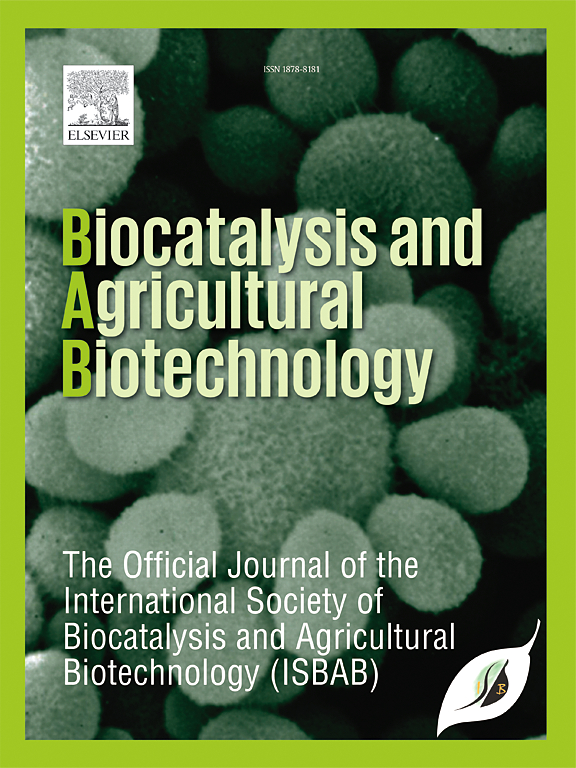绿色合成氧化镁纳米颗粒的石油selinum提取物及其有效的抗菌和伤口愈合性能
IF 3.8
Q2 BIOTECHNOLOGY & APPLIED MICROBIOLOGY
引用次数: 0
摘要
植物介导的绿色合成因其简单、经济、环保和多功能性而越来越受欢迎。基于植物提取物的金属氧化物纳米颗粒的合成促进了无毒纳米颗粒的生产,因为存在几种有益于生物和制药应用的植物化学物质和生化化合物。本研究以石竹叶提取物为原料,制备了氧化镁纳米颗粒。利用紫外-可见光谱对合成的氧化镁纳米粒子的生物物理性质进行了研究。利用傅里叶变换红外光谱(FTIR)和扫描电镜(SEM)对纳米颗粒的官能团和形貌进行了测定和分析。紫外可见光谱法在210 nm处测得最大峰。这一发现表明在样品中形成了氧化镁纳米颗粒。FTIR结果表明,官能团的修饰是纳米颗粒形成的主要原因。氧化镁的存在由652 cm-1处的峰证实。此外,SEM图像显示样品的粒径在50-100 nm之间。随后,研究转向评估绿色合成的氧化镁纳米颗粒对健康人皮肤成纤维细胞的潜在毒性。研究表明,该颗粒在0 ~ 400 μg/mL浓度范围内无毒性。此外,生物合成颗粒具有促进体外创伤模型细胞增殖的潜力。此外,MgO纳米颗粒对大肠杆菌和金黄色链球菌的抗菌活性也得到了证实。本文章由计算机程序翻译,如有差异,请以英文原文为准。
Green synthesis of magnesium oxide nanoparticles by using Petroselinum crispum extract and their potent antibacterial and wound healing properties
The popularity of plant-mediated green synthesis is increasing due to its simplicity, cost-effectiveness, eco-friendliness and versatility. The synthesis of metal oxide nanoparticles based on plant extracts facilitates the production of non-toxic nanoparticles owing to the presence of several plant chemicals and biochemical compounds which are beneficial for biological and pharmaceutical applications. In the present study, leaf extracts of Petroselinum crispum were used for the synthesis of magnesium oxide (MgO) nanoparticles. The biophysical properties of the synthesized MgO nanoparticles were investigated using ultraviolet–visible spectroscopy. Furthermore, Fourier-transform infrared spectroscopy (FTIR) and scanning electron microscopy (SEM) were employed to determine and analyse the functional groups and morphology of the nanoparticles. The maximum peak was found at 210 nm using UV–visible spectroscopy. This finding is indicative of the formation of MgO nanoparticles within the sample. The FTIR results showed that the modifications in the functional groups are responsible for the formation of nanoparticles. The presence of magnesium oxide was confirmed by the peak at 652 cm-1. Furthermore, the SEM images revealed that the particle size of the samples was in the range of 50–100 nm. The investigation then turned to the assessment of the potential toxicity of the green-synthesized MgO nanoparticles in healthy human dermal fibroblasts. The study revealed that the particles were not toxic in the concentration range of 0–400 μg/mL. Furthermore, the biosynthesised particles have the potential to promote cell proliferation in vitro wound model. In addition, the antimicrobial activity of the MgO nanoparticles against Escherichia coli and Streptococcus aureus bacteria was demonstrated.
求助全文
通过发布文献求助,成功后即可免费获取论文全文。
去求助
来源期刊

Biocatalysis and agricultural biotechnology
Agricultural and Biological Sciences-Agronomy and Crop Science
CiteScore
7.70
自引率
2.50%
发文量
308
审稿时长
48 days
期刊介绍:
Biocatalysis and Agricultural Biotechnology is the official journal of the International Society of Biocatalysis and Agricultural Biotechnology (ISBAB). The journal publishes high quality articles especially in the science and technology of biocatalysis, bioprocesses, agricultural biotechnology, biomedical biotechnology, and, if appropriate, from other related areas of biotechnology. The journal will publish peer-reviewed basic and applied research papers, authoritative reviews, and feature articles. The scope of the journal encompasses the research, industrial, and commercial aspects of biotechnology, including the areas of: biocatalysis; bioprocesses; food and agriculture; genetic engineering; molecular biology; healthcare and pharmaceuticals; biofuels; genomics; nanotechnology; environment and biodiversity; and bioremediation.
 求助内容:
求助内容: 应助结果提醒方式:
应助结果提醒方式:


